Erika Mailman's Blog, page 15
September 21, 2013
Interview with Kathleen Kent
<!-- /* Font Definitions */ @font-face {font-family:Helvetica; panose-1:2 11 6 4 2 2 2 2 2 4; mso-font-charset:0; mso-generic-font-family:swiss; mso-font-format:other; mso-font-pitch:variable; mso-font-signature:3 0 0 0 1 0;} @font-face {font-family:"ヒラギノ角ゴ Pro W3"; mso-font-charset:0; mso-generic-font-family:roman; mso-font-pitch:auto; mso-font-signature:0 0 0 0 0 0;} /* Style Definitions */ p.MsoNormal, li.MsoNormal, div.MsoNormal {mso-style-parent:""; margin:0in; margin-bottom:.0001pt; mso-pagination:widow-orphan; font-size:12.0pt; font-family:"Times New Roman"; mso-fareast-font-family:"Times New Roman";} p.HeaderFooter, li.HeaderFooter, div.HeaderFooter {mso-style-name:"Header & Footer"; mso-style-parent:""; margin:0in; margin-bottom:.0001pt; mso-pagination:widow-orphan; tab-stops:right 6.5in; font-size:10.0pt; font-family:Helvetica; mso-fareast-font-family:"ヒラギノ角ゴ Pro W3"; mso-bidi-font-family:"Times New Roman"; color:black;} p.FreeForm, li.FreeForm, div.FreeForm {mso-style-name:"Free Form"; mso-style-parent:""; margin:0in; margin-bottom:.0001pt; mso-pagination:widow-orphan; font-size:12.0pt; mso-bidi-font-size:10.0pt; font-family:Helvetica; mso-fareast-font-family:"ヒラギノ角ゴ Pro W3"; mso-bidi-font-family:"Times New Roman"; color:black;} @page Section1 {size:8.5in 11.0in; margin:1.0in 1.0in 1.0in 1.0in; mso-header-margin:.5in; mso-footer-margin:.6in; mso-paper-source:0;} div.Section1 {page:Section1;} /* List Definitions */ @list l0 {mso-list-id:1; mso-list-template-ids:-1991317389;} @list l0:level1 {mso-level-start-at:5; mso-level-legal-format:yes; mso-level-tab-stop:13.0pt; mso-level-number-position:left; margin-left:13.0pt; text-indent:0in; mso-text-raise:0pt;} @list l0:level2 {mso-level-number-format:alpha-lower; mso-level-tab-stop:13.0pt; mso-level-number-position:left; margin-left:13.0pt; text-indent:.25in; mso-text-raise:0pt;} @list l0:level3 {mso-level-number-format:roman-lower; mso-level-tab-stop:13.0pt; mso-level-number-position:left; margin-left:13.0pt; text-indent:.5in; mso-text-raise:0pt;} @list l0:level4 {mso-level-legal-format:yes; mso-level-tab-stop:13.0pt; mso-level-number-position:left; margin-left:13.0pt; text-indent:.75in; mso-text-raise:0pt;} @list l0:level5 {mso-level-number-format:alpha-lower; mso-level-tab-stop:13.0pt; mso-level-number-position:left; margin-left:13.0pt; text-indent:1.0in; mso-text-raise:0pt;} @list l0:level6 {mso-level-number-format:roman-lower; mso-level-tab-stop:13.0pt; mso-level-number-position:left; margin-left:13.0pt; text-indent:1.25in; mso-text-raise:0pt;} @list l0:level7 {mso-level-legal-format:yes; mso-level-tab-stop:13.0pt; mso-level-number-position:left; margin-left:13.0pt; text-indent:1.5in; mso-text-raise:0pt;} @list l0:level8 {mso-level-number-format:alpha-lower; mso-level-tab-stop:13.0pt; mso-level-number-position:left; margin-left:13.0pt; text-indent:1.75in; mso-text-raise:0pt;} @list l0:level9 {mso-level-number-format:roman-lower; mso-level-tab-stop:13.0pt; mso-level-number-position:left; margin-left:13.0pt; text-indent:2.0in; mso-text-raise:0pt;} ol {margin-bottom:0in;} ul {margin-bottom:0in;} </style> --> <div class="separator" style="clear: both; text-align: center;"><a href="http://4.bp.blogspot.com/-O83xJLvaIAM..." imageanchor="1" style="margin-left: 1em; margin-right: 1em;"><img border="0" src="http://4.bp.blogspot.com/-O83xJLvaIAM..." /></a></div><br /><div class="FreeForm">I’m so proud and happy to host a Q&A today with Kathleen Kent. Kathleen’s a fantastic writer and her topics are near and dear to my heart: witchcraft (<i>The Heretic’s Daughter</i>), Colonial Massachusetts (<i>The Wolves of Andover, </i>also titled <i>The Traitor’s Wife</i>, but I love the consonance of the first title), and the lawless Old West (her latest novel, <i>The Outcasts</i>, which releases on Sept. 24, three days from now. Order now!)</div><div class="FreeForm"><br /></div><div class="FreeForm">Kathleen gave me an ARC at the Historical Novels Society conference in June. I devoured it and loved it; it really is a wonderful book and filled with harrowing scenes and lots of good plot twists. Here is our interview: </div><div class="FreeForm"><br /></div><div class="FreeForm"><br /></div><div class="FreeForm"><b>Q: In your new book <i>The Outcasts </i>you write two different character’s storylines: Lucinda Carter, who escapes a brothel and journeys to meet up with an old acquaintance, and Nate Cannon, doing a stint with the Texas Rangers. Was it difficult to write from a male perspective?</b></div><div class="FreeForm"><br /></div><div class="FreeForm">KK: No, I didn’t find it difficult at all. My second novel, <i>The Traitor’s Wife</i>, was written from various male points of view, as well as female. We all have masculine and feminine traits and intuitions, and part of the joy of being a writer is trying on all of those personas. I also think growing up with a dad who was a great storyteller of Texas legends helped to plant the voices in my head. From him I adopted the pride, awe and, at times, despair for the wild, rough-edged and dangerous men and women who settled the early frontier. </div><div class="FreeForm"><br /></div><div class="FreeForm"><br /></div><div class="FreeForm"><b>Q: What kind of research did you do to understand the psychology of someone who</b></div><div class="FreeForm"><b>knows their lover does despicable, harmful things to others—and yet still fiercely loves and admires them?</b></div><div class="FreeForm"><br /></div><div class="FreeForm">KK: There are so many stories in the history books, ancient and modern, of otherwise reasonable, intelligent women falling for unscrupulous men. Certainly it still happens today. All you have to do is open the paper (or click on the story while on-line) to see the destruction and carnage as a result of a woman aiding and supporting a bad man on a crime spree. As a character study, it was interesting to develop Lucinda’s growing dependence on her lover and the way she rationalizes his character and behavior. In a time when women had---and in many places still have---so few choices in their own destinies, it was easier and at times safer to turn a blind eye to misdeeds. </div><div class="FreeForm"><br /></div><div class="FreeForm"><b>Q: We talked about your striking cover art in person. Can you talk a little bit about your input, and your feelings about the image? Is that gun *the* gun?</b></div><div class="FreeForm"><br /></div><div class="separator" style="clear: both; text-align: center;"><a href="http://1.bp.blogspot.com/-xNgZhj57pTY..." imageanchor="1" style="clear: right; float: right; margin-bottom: 1em; margin-left: 1em;"><img border="0" height="320" src="http://1.bp.blogspot.com/-xNgZhj57pTY..." width="207" /></a></div><div class="FreeForm">KK: I’ve been really fortunate in that regard as I’ve had a lot of say in the publisher’s choosing the cover art for my first two novels. For <i>The Outcasts</i> we discussed concepts first and then started looking at images. When I was shown the image that everyone seemed to love the most, I was equally enthusiastic about it. . .all except for the gun the woman is holding. Originally, the gun in the photo was a flintlock pistol from the late 1700s. It was a beautiful weapon, but completely inappropriate to the era. I sent back some images of Colt revolvers and, through the magic of photoshopping, the gun was magically transformed. If there’s one thing Texans know, it’s their guns! The gun that Lucinda carries in the novel is a small Remington derringer, effective in close quarters, but too small to look impressive on a book jacket. </div><div class="FreeForm"><br /></div><div class="FreeForm">Q: I know from your blog you’ve been interested in rumors of buried treasure in Middle Bayou. Did you have a similar fascination with the Texas Rangers?</div><div class="FreeForm"><br /></div><div class="FreeForm">KK: Growing up in Texas I was fascinated by the legends of the Texas Rangers. One of my father’s distant relatives, Thomas Hickman, is in the Ranger Hall of Fame and was most noted for keeping law and order in the wild North Texas oil-boom towns where my dad grew up. The Rangers of 19th c. Texas seemed to be a law unto themselves and were left unchallenged by government and welcomed by the settlers of the Republic to pursue their own unsanctioned and often violent methods of keeping the peace. After the Civil War, the Rangers were disbanded for a short while, but they continued to protect and serve unofficially, their experience and loyalty to the brotherhood often times more effective than the newly formed Texas State Police in keeping bushwackers, carpetbaggers, cattle and horse thieves at bay. </div><div class="FreeForm"><br /></div><div class="FreeForm"><b>Q: What are you working on next?</b></div><div class="FreeForm"><br /></div><div class="FreeForm">KK: I have two projects that I’ve begun and I’ll have to decide soon which manuscript to finish before the other. The first is a historical novel set in 1910 in a Pennsylvania coal town and involves a mining accident and missing children. The second is a contemporary novel based on a short story, “Coincidences Can Kill You”, that will be published this November in <i>Dallas Noir</i>, an anthology of crime stories by Dallas authors.</div><div class="FreeForm"><br /></div><div class="FreeForm"><i>Thanks so much, Kathleen! I wish you a world of luck with your launch in a few days. I'm sure we will be seeing this one on the NYT bestseller list as well. </i></div><div class="FreeForm"><br /></div><div class="FreeForm"><br /></div><div class="FreeForm">. . . . </div><div class="FreeForm"><br /></div><div class="FreeForm"><br /></div><div class="FreeForm"><br /></div><div class="FreeForm"><br /></div><div class="FreeForm" style="margin-bottom: 12pt;"><br /></div>
Published on September 21, 2013 17:02
September 3, 2013
Maiden Lane Press launches today with Moonrise
That novel, a retelling-of-sorts of Rebecca by Daphne DuMaurier, launches today!
Rusoff held a design competition to create the imprint’s gas lamp logo. She and her partner Michael Radulescu pored through listings of gods, goddesses and titans to find a name for their press, finally fastening on Maiden Lane, an evocative place name.
Today’s book launch is a hopeful testing ground for Rusoff. If all goes well, she may begin publishing her clients’ backlists or other items of interest, such as a commencement speech given by Arthur Phillips, author of Prague, or Jonathan Odell’s first novel, now out of print.
More than that, though, Moonrise is dedicated to Cassandra King’s sister Nancy, a teacher who died just as the book was finished. Both Daphne DuMaurier and Nancy would be proud of their very different but personal associations with this novel, one readers are saying is King’s best book yet.
Here’s a description of the book from the author’s website:
Helen Honeycutt is just getting her life back on track after a bitter divorce when she meets Emmet Justice, an attractive widower still grieving for his late wife, Rosalyn. Their sudden marriage sets off a maelstrom of resentment and ill-will among Rosalyn’s family and friends. Hoping to mend fences, the newlyweds plan a summer at Moonrise, Rosalyn’s historic estate in the Blue Ridge Mountains. Moonrise is known far and wide for its unique nocturnal gardens, which have fallen into ruin since the death of its mistress.
Like the heroine of Daphne DuMaurier’s classic romance, Rebecca, Helen becomes obsessed by her predecessor, who lives on in her house and gardens and the hearts of those who loved her. Not only does Helen fail to measure up to the beautiful and accomplished Rosalyn, she doesn’t fit into her world, either, an elite enclave of well-to-do summer people. Even the gardens exclude her, since their secrets, passed down by generations of gardeners, died out with Rosalyn. When it becomes clear that someone in Rosalyn’s close-knit circle of friends is determined to drive her away, Helen wonders if she can trust anyone, even her husband. As the sweltering summer draws to an end, Helen must uncover the secrets of the past in order to establish her own identity apart from the woman she replaced.
The book is available in hardcover or Audible format.
King is the wife of author Pat Conroy. A few prepub blurbs:
“A suspenseful Gothic that gives a nod to its predecessors while still being fresh”--Publisher’s Weekly
“Moonrise is a fantastic, not-to-be-missed novel."-- Anne River Siddons, author of The House Next Door
"I read Moonrise in a single greedy gulp.” -- Meg Waite Clayton, author of The Wednesday Sisters
Congratulations to Cassandra, Marly and Maiden Lane Press!
Published on September 03, 2013 09:53
July 19, 2013
Claws of the Cat launch!
My friend Susan Spann held her debut novel's book launch last night at Face in a Book in El Dorado Hills, California. It was a fantastic evening and I'm so glad the world now gets a chance to read her incredible book, Claws of the Cat. It's the first in a series featuring a medieval ninja crime-solver, Hiro Hattori, and his Portugeuse priest sidekick, Father Matteo. Here's a taste of the evening, rendered in photographs!
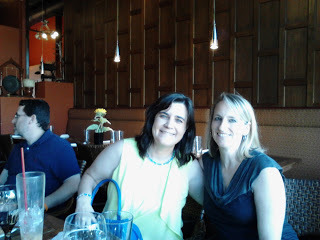 At Chantara Thai beforehand.
At Chantara Thai beforehand.
A group of us ate beforehand, steps away from the bookstore, at Chantara Thai. It was lovely to get a chance to meet Susan's parents who had flown up from Southern California for the event, as well as other friends of Susan's I hadn't met before. What a nice group of people. And thank you Paula and Spencer for dinner!
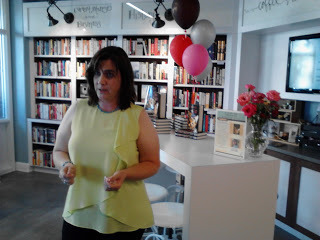 Just before the reading. Look what a nice display the bookstore made behind her!
Just before the reading. Look what a nice display the bookstore made behind her!
Face In A Book is a really great bookstore, and I'm so happy Susan had her launch there. It's a wonderful independent bookstore that supports its local authors.
 The author with scads of her books; the piles were depleted ere the night was over!Susan read from Chapter Four of her book and then answered questions from the audience. I asked a question I already knew the answer to, because it's so impressive. I asked, "How far out have you plotted this series?" THIRTEEN BOOKS INTO THE FUTURE, PEOPLE! I can't even conceive of that kind of planning. Frankly, I don't know what I'll be doing 13 days from now, let alone 13 books from now. Susan's contract with Minotaur is for a trilogy but I have no doubt whatsoever they will be signing her on for the rest soon.
The author with scads of her books; the piles were depleted ere the night was over!Susan read from Chapter Four of her book and then answered questions from the audience. I asked a question I already knew the answer to, because it's so impressive. I asked, "How far out have you plotted this series?" THIRTEEN BOOKS INTO THE FUTURE, PEOPLE! I can't even conceive of that kind of planning. Frankly, I don't know what I'll be doing 13 days from now, let alone 13 books from now. Susan's contract with Minotaur is for a trilogy but I have no doubt whatsoever they will be signing her on for the rest soon.
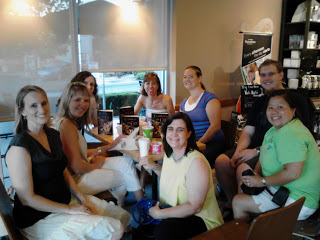 Adjourned for coffee afterwards with friendsAfterwards some of us walked a block away to Starbucks (I love Town Center). I made everyone display their books on the table...and poor Susan had to sit on the floor. Not pictured are two other sweethearts who came: Diana and Heidi.
Adjourned for coffee afterwards with friendsAfterwards some of us walked a block away to Starbucks (I love Town Center). I made everyone display their books on the table...and poor Susan had to sit on the floor. Not pictured are two other sweethearts who came: Diana and Heidi.
Postscript 1:
My husband read the first chapter the next morning, standing in the kitchen as he oversaw French toast production. He said, "Her prose is like Hemingway." I kid you not!
Postscript 2:
Someone else in the household thought the title was "Laws of the Cat" (which is funny because Susan is an attorney), and proceeded to list what those might be:
Do not scratch a humanAlways brush your fur straightAlways put the right catfood in your catbowlAlways do what the police cat says
On that note, good night! Congratulations, Susan. I couldn't be prouder or happier for you.
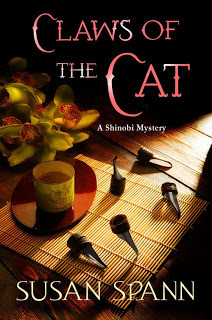
. . . . .
 At Chantara Thai beforehand.
At Chantara Thai beforehand.A group of us ate beforehand, steps away from the bookstore, at Chantara Thai. It was lovely to get a chance to meet Susan's parents who had flown up from Southern California for the event, as well as other friends of Susan's I hadn't met before. What a nice group of people. And thank you Paula and Spencer for dinner!
 Just before the reading. Look what a nice display the bookstore made behind her!
Just before the reading. Look what a nice display the bookstore made behind her!Face In A Book is a really great bookstore, and I'm so happy Susan had her launch there. It's a wonderful independent bookstore that supports its local authors.
 The author with scads of her books; the piles were depleted ere the night was over!Susan read from Chapter Four of her book and then answered questions from the audience. I asked a question I already knew the answer to, because it's so impressive. I asked, "How far out have you plotted this series?" THIRTEEN BOOKS INTO THE FUTURE, PEOPLE! I can't even conceive of that kind of planning. Frankly, I don't know what I'll be doing 13 days from now, let alone 13 books from now. Susan's contract with Minotaur is for a trilogy but I have no doubt whatsoever they will be signing her on for the rest soon.
The author with scads of her books; the piles were depleted ere the night was over!Susan read from Chapter Four of her book and then answered questions from the audience. I asked a question I already knew the answer to, because it's so impressive. I asked, "How far out have you plotted this series?" THIRTEEN BOOKS INTO THE FUTURE, PEOPLE! I can't even conceive of that kind of planning. Frankly, I don't know what I'll be doing 13 days from now, let alone 13 books from now. Susan's contract with Minotaur is for a trilogy but I have no doubt whatsoever they will be signing her on for the rest soon. Adjourned for coffee afterwards with friendsAfterwards some of us walked a block away to Starbucks (I love Town Center). I made everyone display their books on the table...and poor Susan had to sit on the floor. Not pictured are two other sweethearts who came: Diana and Heidi.
Adjourned for coffee afterwards with friendsAfterwards some of us walked a block away to Starbucks (I love Town Center). I made everyone display their books on the table...and poor Susan had to sit on the floor. Not pictured are two other sweethearts who came: Diana and Heidi.Postscript 1:
My husband read the first chapter the next morning, standing in the kitchen as he oversaw French toast production. He said, "Her prose is like Hemingway." I kid you not!
Postscript 2:
Someone else in the household thought the title was "Laws of the Cat" (which is funny because Susan is an attorney), and proceeded to list what those might be:
Do not scratch a humanAlways brush your fur straightAlways put the right catfood in your catbowlAlways do what the police cat says
On that note, good night! Congratulations, Susan. I couldn't be prouder or happier for you.

. . . . .
Published on July 19, 2013 21:38
July 11, 2013
Historical Novels Society conference 2013: The Vinoy
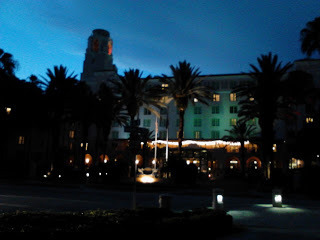 The Vinoy at night, from the waterfront
The Vinoy at night, from the waterfrontI previously posted about the panel I served on, along with Kathleen Kent, Mary Sharratt and Suzy Witten, three fabulous and fascinating novelists who write about witchcraft. Now I'd like to talk about the Vinoy Hotel, where the conference was held....because it really was an amazing hotel.
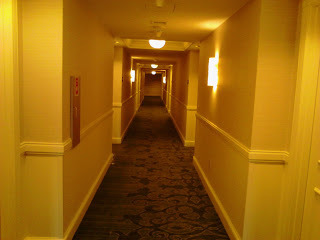 I kept expecting to see Danny on his Big Wheel coming down the hallwayIt was very Floridian, with pink shell color on its Art Deco facade, but it also gave me Overlook overtones. It was a hotel of the same era, where people would come for the entire season and attend those balls with live orchestras.
I kept expecting to see Danny on his Big Wheel coming down the hallwayIt was very Floridian, with pink shell color on its Art Deco facade, but it also gave me Overlook overtones. It was a hotel of the same era, where people would come for the entire season and attend those balls with live orchestras.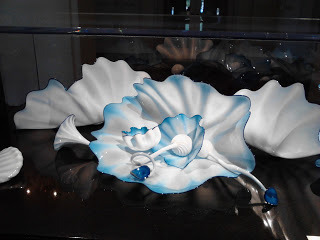 Chihuly glasswork in the lobby caseIn the lobby (besides an incredible Chihuly display), a collection of photos showcased the hotel's history and its astounding multimillion-dollar renovation. It had spent 18 years empty; there's something so evocative to me about formerly grand places in decay (viz., the Titanic).
Chihuly glasswork in the lobby caseIn the lobby (besides an incredible Chihuly display), a collection of photos showcased the hotel's history and its astounding multimillion-dollar renovation. It had spent 18 years empty; there's something so evocative to me about formerly grand places in decay (viz., the Titanic).The Chihuly Museum is here in town (the town being St. Petersburg, Florida). I really wanted to go. I love Chihuly, who I first encountered upon entering the San Jose Museum of Art, where he has two enormous hanging glass pieces in the front lobby...which made me think in an earthquake, I'd know exactly where not to stand. And then in the Bellagio in Las Vegas, I marveled at the magnificent Fiori di Como ceiling near the registration desks. Finally, Dale Chihuly gets sort of bandied about in a novel I'd just read called Where'd You Go Bernadette, which I loved beyond speaking, so I was really excited to see the evidence of his handiwork here and there in the hotel. Unfortunately, I wasn't able to swing visiting the museum although I walked right past it. Nor was I able to see the Dali Museum, whose architecture is said to be one of the top 10 buildings you have to see before you die. Well....now I don't have to die, right?
 The Chihuly chandelier in the Vinoy ballroom...I was not the only one to see a Medusa in it
The Chihuly chandelier in the Vinoy ballroom...I was not the only one to see a Medusa in it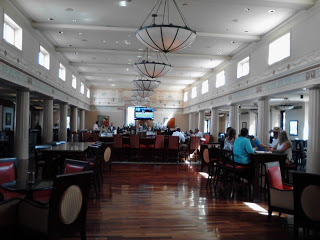 Lovely architectural details abound in the bar. Because that's what matters in a bar.
Lovely architectural details abound in the bar. Because that's what matters in a bar.
The hotel's bar was really lovely and I'm happy to say I spent a fair amount of time here chatting with friend and fellow novelist Vanitha Sankaran and then later....dancing to the DJ with a bunch of other booty-bumping HNSers. I didn't know until the next day that it was a wedding party. Without the veils and bouquets, who can tell?
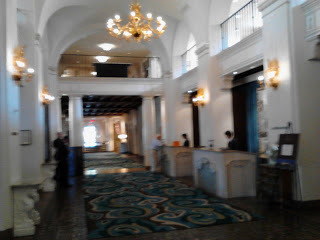 Darn, it's out of focus. This is the muy cool lobby.
Darn, it's out of focus. This is the muy cool lobby.Angry at myself for not getting a better shot of the lobby, the heart of the hotel after all. This is the room where you try to rally after a redeye flight, when it's 6 a.m. their time, 3 a.m. your time, and your room won't be ready for another couple hours. Luckily, there's a veranda with a great view of the boats in the marina so you can slump and contemplate dry heat versus humid heat until your room is ready.
But the room is worth waiting for!
 My view as I walked in....why, are those chairs for reading? How lovely of you, Vinoy!
My view as I walked in....why, are those chairs for reading? How lovely of you, Vinoy! View from other side of the room. Love the lime walls with magenta chairs.
View from other side of the room. Love the lime walls with magenta chairs.The room was gorgeous and I contemplated sleeping on each bed on alternate nights. Instead, I stuck with the one by the door so I'd be aware and ready when Jack Torrance came with the ax. Actually, the Vinoy is reputed to be haunted. When I made my reservation, I specifically asked for a room that was not haunted. The woman laughed and said, But we need fresh souls from California.
She didn't really say that. I would have loved it if she had.
 A room with a view: Helena Bonham Carter, eat your heart out!I had two windows with lovely views that really underscored I was in Florida. Palm trees! It's hard to tell, but the aqua square is a lovely fountain, and the white chairs are all set up for the wedding whose dance party would be later overtaken by bookish drunks on a tear. I kept looking at this picture, wondering what the odd pale business card looking thing is, with the blue stripe hanging down, towards the left of center. I just figured it out: it's my necklace thing, what's it called? That you wear around your neck so you can get into the conference? And the blue dangler said "Speaker" on it. It had flipped around backward to be immortalized in the window reflection.
A room with a view: Helena Bonham Carter, eat your heart out!I had two windows with lovely views that really underscored I was in Florida. Palm trees! It's hard to tell, but the aqua square is a lovely fountain, and the white chairs are all set up for the wedding whose dance party would be later overtaken by bookish drunks on a tear. I kept looking at this picture, wondering what the odd pale business card looking thing is, with the blue stripe hanging down, towards the left of center. I just figured it out: it's my necklace thing, what's it called? That you wear around your neck so you can get into the conference? And the blue dangler said "Speaker" on it. It had flipped around backward to be immortalized in the window reflection.I think that's all for the Vinoy. In my next post, I'll share images of some of the sessions I attended.
. . . . .
Published on July 11, 2013 15:40
June 28, 2013
Ann Marie Meyers: Up in the Air

I'm going to take a little break from the wrap-up posts about the Historical Novels Conference this last weekend in St. Petersburg to host an old buddy.
Ann Marie is someone I remember fondly from the old days at the San Francisco Writers Workshop. We both attended religiously about six or seven years ago. Now she has a children's book out called Up In the Air. Isn't that a gorgeous cover?
I'm very happy to host her today with a little Q&A about the process of writing this book and her career in general.
1) What inspires you to write
I get my inspiration from just about anything. Something I read, or overhear; a thought that flashes through my mind, the look on someone’s face; my dreams, especially my dreams. Sometimes I just let my mind go blank and write down the very first thing I think of and then see where that takes me. My very first book was written this way.
2) What about Up In The Air. Which form of inspiration did that take?
Surprisingly, neither of the above. The idea came to me while I was meditating one day. That was the first and, as of now, the last time such a thing has happened to me.
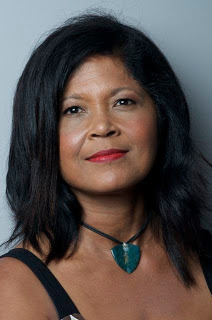 Ann Marie Meyers
Ann Marie Meyers3) Did you always want to write?
No. Definitely not. I have always enjoyed reading. I devoured hundreds of books when I was young, and I loved writing essays in school and letting my imagination fly. Then, one day, (in my late teens actually) to my utter shock, I started a journal and the very first words I wrote were: “I want to be a writer”. I have no idea where that thought came from, though I didn’t actually start to write until much later, and even then I didn’t embrace the idea at first. I resisted.
Some of the famous authors I studied in school (eg: James Joyce and D. H. Lawrence) were so unhappy I wanted no part of it. I wanted to be happy, unfettered by depression (idealistic but true). Eventually though, over time, I learned to accept the fact that I wanted, even needed, to write and create stories.
4) AndQuite by chance actually. I remember seeing advertisements appealing to people to write children’s books, but I never paid any attention to them. After my daughter was born, I began having thoughts about what she might like to read but it wasn’t until she was about 3 years old that I actually wrote my first children’s book, Up In The Air.
. . . .
Published on June 28, 2013 18:07
June 25, 2013
HNS 2013: the witchcraft panel
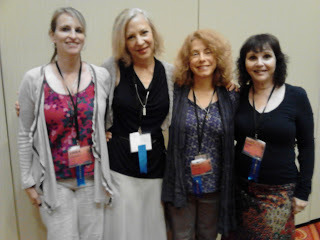 From left: me, Kathleen, Mary, Suzy, before the panel
From left: me, Kathleen, Mary, Suzy, before the panelJust got back from the Historical Novels Society conference (held this year in St. Petersburg, Florida), and just can't stop thinking about how much fun it was. Surrounded by people who get what I'm fascinated by, who are kind and supportive and part of a great community of writers and readers (and editors/agents too!)...people who don't mind shaking a little booty to the DJ in the bar after hours...ha!
I'll be doing many wrap-up posts, but this one is about the witchcraft panel I participated in with three wonderful, wonderful women: Kathleen Kent, Mary Sharratt and Suzy Witten.
Since we all live in different areas of the country, we decided to meet at the conference to plan our panel the day before the presentation.We'd previously agreed on the tenor of the discussion and even come up with a few questions to talk about, but we wanted to chat and plan further. Kathleen was a champ: her flight had been delayed, so she showed up to our get-together fresh off the hotel shuttle!
Immediately we began to see that this was a lovely meeting of the minds, that we'd have no trouble talking about this topic to fill our allotted time. We then continued on to dinner together and continued discussion there.
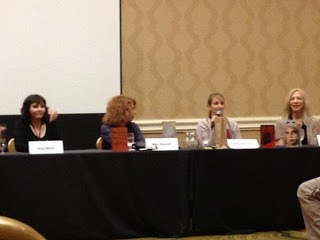 From left: Suzy, Mary, me, KathleenThe next day, our panel went really well. We had some great audience questions and acquitted ourselves well, I think. :) We raffled off copies of our books, and that's the paper bag you see in front of me on the table (no, it wasn't Thunderbird!)
From left: Suzy, Mary, me, KathleenThe next day, our panel went really well. We had some great audience questions and acquitted ourselves well, I think. :) We raffled off copies of our books, and that's the paper bag you see in front of me on the table (no, it wasn't Thunderbird!)I've got nothing but warm fuzzies for these ladies. I'm hopeful we'll all meet again at HNS 2015 if not earlier!
. . . . .
Published on June 25, 2013 18:16
June 13, 2013
Literary (and in no way despicable) Me
After a long hiatus of experiencing no literary events, I just went through a few weeks of very happy creative activity with other writers. The first was attending Summerwords, a creative writing colloquium at American River College in Sacramento. I was there at the invitation of Michael Spurgeon, organizer and faculty member there, who released his first novel during the conference. Although Michael and I never met before six months ago, we attended the same very small liberal arts college in Maine, Colby College, attended the same MFA program in Tucson, Arizona, and both wound up in the greater Sacramento area. Coincidences too great to be ignored! Facebook brought us together and we had coffee and compared notes on our shared, but not shared, experiences.
Here's a photo of Michael and his friend, fellow author Christian Kiefer, chatting during an audience Q&A following their joint reading at Summerwords. The goody bags had both their novels in it. Score!
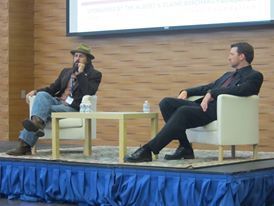
Christian, on the left, is the author of The Infinite Tides, which looks like a great read. I'm in the middle of Michael's book Let The Water Hold Me Down now, which is wonderful. Photo courtesy of Bethanie Humphreys.
Next I need to talk about T.C.Boyle, who read a short story and did audience Q&A. Oh, this man. His source of charm must be located and destroyed. He must have kissed the Blarney Stone, located in the parapet of a castle in County Cork, Ireland, which confers wit, charm and eloquence upon the kisser. Although it appears clear he didn't just kiss it, but made out with it. I posit that T.C. Boyle frenched the Blarney Stone.
I was there as a presenter, and did a workshop on how to research and outline a novel. People seemed receptive and afterwards a young woman came up and said something so sweet I had to hug her. Then I went to the main hall and did a reading from The Witch's Trinity and signed books. The energy at Summerwords was honestly so upbeat and happy...I just loved the whole weekend. Bravo to the organizers!
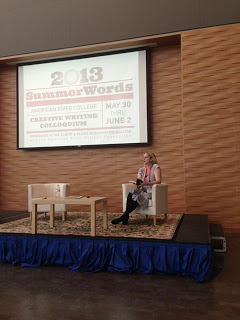
That's me reading from Witch's Trinity, above. One final picture from the weekend...I mentioned above that Michael and I attended Colby College. Well, another person was there from Colby too: literary agent Eleanor Jackson. She represents Christian Kiefer and a slew of other wonderful authors. It's truly a small world! And Colby's English Department rocks. From left: Michael Spurgeon, Eleanor Jackson, and me.
 All right, on to my next literary adventure. Last week, my friend Susan Spann (her first novel Claws of the Cat launches next month. Two words: ninja hero. Need I say more?) headed to a reading for Karen Joy Fowler's latest book. She gave a great reading and I'm dying to start her book! Especially since there's apparently a big plot spoiler event early on in the novel. She had us raise our hands to say if we knew already so she could talk about it. She gave a very generous Q&A and signed books.
All right, on to my next literary adventure. Last week, my friend Susan Spann (her first novel Claws of the Cat launches next month. Two words: ninja hero. Need I say more?) headed to a reading for Karen Joy Fowler's latest book. She gave a great reading and I'm dying to start her book! Especially since there's apparently a big plot spoiler event early on in the novel. She had us raise our hands to say if we knew already so she could talk about it. She gave a very generous Q&A and signed books.
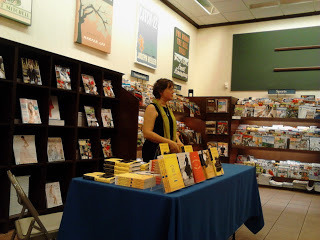 This was her at the Barnes & Noble in Citrus Heights, CA. Many audience members had been part of her writers group many years ago, so it was neat to hear the familiar back and forth.
This was her at the Barnes & Noble in Citrus Heights, CA. Many audience members had been part of her writers group many years ago, so it was neat to hear the familiar back and forth.
My next literary adventure is in a few weeks. I'm off to the Historical Novels Society conference in St. Petersburg, Florida. I'll be on a panel called "The Witchcraft Window: Scrying the Past." I have to admit I shamelessly stole the idea from a previous panel put together by someone else (I'd love to know who! Ann Kent?) at Book Group Expo in San Jose way back in 2008. Here's a "historic" picture of us then:
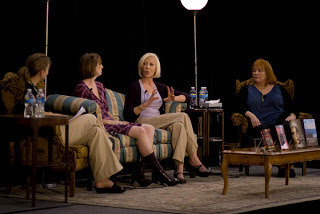
From left, moderator Michelle Gagnon, me (how I miss those boots), Kathleen Kent, and Brunonia Barry. Photo courtesy of Secret Sushi, Flickr.
From this crowd, only Kathleen and I will be in St. Petersburgh, with added ranks of Mary Sharratt and Suzy Witten. Excited to see all three of these wonderful women again, as well as others I met at HNS 2011 in San Diego.
Writing is such a solitary activity--when we can get together, talk craft, laugh, have a glass of wine and listen to sex scenes...oh wait. I forgot (literally! I was just about to wrap up this post). I'm going to be reading a sex scene from Woman of Ill Fame at HNS too. Moderated by the supreme Diana Gabaldon, this event is a Saturday night standard at the conference. I'm going to gulp some courage and read a scene. Wish me luck.
. . . .
Here's a photo of Michael and his friend, fellow author Christian Kiefer, chatting during an audience Q&A following their joint reading at Summerwords. The goody bags had both their novels in it. Score!

Christian, on the left, is the author of The Infinite Tides, which looks like a great read. I'm in the middle of Michael's book Let The Water Hold Me Down now, which is wonderful. Photo courtesy of Bethanie Humphreys.
Next I need to talk about T.C.Boyle, who read a short story and did audience Q&A. Oh, this man. His source of charm must be located and destroyed. He must have kissed the Blarney Stone, located in the parapet of a castle in County Cork, Ireland, which confers wit, charm and eloquence upon the kisser. Although it appears clear he didn't just kiss it, but made out with it. I posit that T.C. Boyle frenched the Blarney Stone.
I was there as a presenter, and did a workshop on how to research and outline a novel. People seemed receptive and afterwards a young woman came up and said something so sweet I had to hug her. Then I went to the main hall and did a reading from The Witch's Trinity and signed books. The energy at Summerwords was honestly so upbeat and happy...I just loved the whole weekend. Bravo to the organizers!

That's me reading from Witch's Trinity, above. One final picture from the weekend...I mentioned above that Michael and I attended Colby College. Well, another person was there from Colby too: literary agent Eleanor Jackson. She represents Christian Kiefer and a slew of other wonderful authors. It's truly a small world! And Colby's English Department rocks. From left: Michael Spurgeon, Eleanor Jackson, and me.
 All right, on to my next literary adventure. Last week, my friend Susan Spann (her first novel Claws of the Cat launches next month. Two words: ninja hero. Need I say more?) headed to a reading for Karen Joy Fowler's latest book. She gave a great reading and I'm dying to start her book! Especially since there's apparently a big plot spoiler event early on in the novel. She had us raise our hands to say if we knew already so she could talk about it. She gave a very generous Q&A and signed books.
All right, on to my next literary adventure. Last week, my friend Susan Spann (her first novel Claws of the Cat launches next month. Two words: ninja hero. Need I say more?) headed to a reading for Karen Joy Fowler's latest book. She gave a great reading and I'm dying to start her book! Especially since there's apparently a big plot spoiler event early on in the novel. She had us raise our hands to say if we knew already so she could talk about it. She gave a very generous Q&A and signed books. This was her at the Barnes & Noble in Citrus Heights, CA. Many audience members had been part of her writers group many years ago, so it was neat to hear the familiar back and forth.
This was her at the Barnes & Noble in Citrus Heights, CA. Many audience members had been part of her writers group many years ago, so it was neat to hear the familiar back and forth.My next literary adventure is in a few weeks. I'm off to the Historical Novels Society conference in St. Petersburg, Florida. I'll be on a panel called "The Witchcraft Window: Scrying the Past." I have to admit I shamelessly stole the idea from a previous panel put together by someone else (I'd love to know who! Ann Kent?) at Book Group Expo in San Jose way back in 2008. Here's a "historic" picture of us then:

From left, moderator Michelle Gagnon, me (how I miss those boots), Kathleen Kent, and Brunonia Barry. Photo courtesy of Secret Sushi, Flickr.
From this crowd, only Kathleen and I will be in St. Petersburgh, with added ranks of Mary Sharratt and Suzy Witten. Excited to see all three of these wonderful women again, as well as others I met at HNS 2011 in San Diego.
Writing is such a solitary activity--when we can get together, talk craft, laugh, have a glass of wine and listen to sex scenes...oh wait. I forgot (literally! I was just about to wrap up this post). I'm going to be reading a sex scene from Woman of Ill Fame at HNS too. Moderated by the supreme Diana Gabaldon, this event is a Saturday night standard at the conference. I'm going to gulp some courage and read a scene. Wish me luck.
. . . .
Published on June 13, 2013 04:15
May 30, 2013
Happy to announce... Annamaria Alfieri
Her book’s description: “It is the most dramatic and tumultuous period in Argentina’s history. Colonel Juan Perón, who had been the most powerful and the most hated man in the country, has been forced out of power. Many people fear that his mistress, radio actress Evita Duarte, will use her skill at swaying the masses to restore him to office. When an obscure young woman is brutally murdered, police detective Roberto Leary concludes that the murderer mistook the girl for Evita, the intended target of someone out to eliminate the popular star from the political scene.” Don’t cry for me, Annamaria….couldn’t resist that terrible joke. All right, let’s get to the meat of the interview, with questions prepared by the wonderful conference organizer Vanitha Sankaran. Do you follow a specific writing and/or research process? Yes. I have the enormous privilege of being a Writer in Residence at the New York Public Library. I am there researching and working four or five days a week. My process is to draft quickly and then polish and polish and polish. For you, what is the line between fiction and fact? I try to portray the facts and the atmosphere of the time and place vividly and more or less accurately. But above all I want to tell a really good story, so I don’t let the details of the history get in the way of pace and the suspense. If I want there to be a full moon on a certain night, I don’t worry if the moon really was full that day. On the other hand, I never portray real people doing things that theperson in question would never have done. Historical character assassination is unnecessary. There are plenty of bad guys in history to go around. Is there a writer, living or deceased, you would like to meet? William Shakespeare, who wrote the greatest historical fiction. Can you tell us about your latest publication? Blood Tango is set in Buenos Aires in 1945, against the most tumultuous period in Argentine history. It imagines the murder of an obscure girl who was Evita Duarte’s body double. The investigator believes the girl was murdered because she wasmistaken for Evita.
* * * *
Good luck with your launch on June 25, Annamaria, and thanks for participating in the blog tour.
. . . . .
* * * *
Good luck with your launch on June 25, Annamaria, and thanks for participating in the blog tour.
. . . . .
Published on May 30, 2013 23:16
May 23, 2013
Tickled to announce...Julianne Douglas!

I’ve always enjoyed popping in and out of Julianne Douglas’s well-written history blog, Writing the Renaissance. No surprise, then, that she will be moderating a panel discussion at the Historical Novels Society conference titled, “Virtual Salon: The Historical Fiction Blog.” This will definitely be a fun one to catch!
I’m hosting Julianne today with questions prepared by Vanitha Sankaran, a fantastic writer and head of HNS’s conference board. Next month is the HNS conference in St. Petersburg, Florida: readers and writers alike are invited to attend.
1. What got you first interested in historical fiction?
Biographies! As a child, I devoured the Childhood of Famous Americans series. I particularly enjoyed the stories about women: Molly Pitcher, Clara Barton, Sacagawea, Amelia Earhart, Betsey Ross. The further in the past the subject lived, the more intriguing I found her story. At the age of 12, I discovered Jean Plaidy's historical novels. Plaidy's books were my first introduction to European history and through them I discovered a new world of kings and queens and courtiers--irresistibly compelling to a romantic teenager. I began to learn French and became a hopeless Francophile. College saw me double-major in English and French. Realizing there still remained many, many books to read, I went on to earn a Ph.D in French literature, specializing in the sixteenth century. When I chose to stay home with my toddlers instead of pursuing an academic career, I began to write historical fiction set in--you guessed it--Renaissance France. I'd found the way to put all that stuff I'd learned to good use!
2. How do you find the people and topics of your books?
My academic work provided me the topic for my first manuscript, The Measure of Silence. In 1990 I published an article on the work of Louise Labé, the first non-noble woman to publish under her own name in France. Louise was an accomplished scholar whose verse was praised by the poetic luminaries of the day. However, being a woman of the merchant class and unable to claim the protection of a noble sponsor, she was vilified as a courtesan--and worse--for daring to "bare" herself to public scrutiny through publication. Determined to tell Louise's story, but not wanting to be bound by the constraints of a fictionalized biography, I created Jollande Carlet, a woman of similar socio-economic background living in the same center of Renaissance culture, the city of Lyons. While the details of Jollande's life differ from those of Louise's and the narrative follows tangents Louise herself would never recognize, Louise's historical situation and achievements support and justify Jollande's fictional ones. The novel is a salute to the long-dead poet, whose courage and resolution laid the groundwork for women writers of today.
A different poet sparked the genesis of my current manuscript. During a graduate seminar years ago, the professor referred to a poem by François I's court poet, Clément Marot. The work was a tribute to Emperor Charles V of Spain, who paid an extended state visit to France in 1539. The poem confused me at the time because I knew next to nothing about Charles V and his relations with France. A few years ago, while searching for a topic for a new novel, I stumbled upon a description of this elaborate visit in a history book. Research proved it to be an exciting moment of artistic and political rivalries as France prepared to woo and impress its arch-enemy. Charles V is no longer a stranger to me, nor are the Italian artists who worked to renovate the château of Fontainebleau in time for the event. Anne d'Étampes, François I's mistress of twenty years, and Catherine Clouet, daughter of the famous portraitist, are my new best friends. If someone had told me that day in class that decades later I'd be quoting Marot's poem in a novel, I would have thought her a few lines short of a sonnet!
3. Do you have a crazy anecdote related to your writing you would like to share?
One evening last November, I attended a talk at my church. The speaker assured us that if we had a question for God and were fully prepared to accept the answer, He would provide it. Now, I'd been having some serious doubts about whether I was following the right path in life. My first manuscript, although it had secured me a first-class agent, hadn't sold; my current manuscript was taking way too long to write and the process itself had become arduous and stressful. My father's death a month earlier had shown me how short life could be; I worried I was wasting the little time I had pursuing a goal that would never amount to anything more than a selfish dream.
I prayed as I drove home, asking God outright: "Do You want me to keep on writing or do something else instead?" I pulled into the driveway and walked to the mailbox to retrieve the day's mail. Imagine my surprise when I pulled out a copy of Writer's Digest with "WRITE THAT NOVEL!" splashed across the cover! Immediately beneath it lay Historical Novels Review. I laughed out loud, tears of gratitude in my eyes. I had received my answer and it couldn't have been any clearer. (I’ve

* * *
Thank you, Julianne! I too loved reading biographies when I was a child, esp. the ones with orange covers: Clara Barton, Louisa May Alcott, all strong women. I loved them.
. . . . .
Published on May 23, 2013 20:50
May 16, 2013
Thrilled to announce...Diana Gabaldon
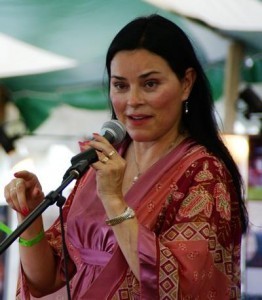
When I signed up to host presenters from the upcoming Historical Novels Society conference on my blog, I had no idea I’d be lucky enough to host big hitters like Diana Gabaldon (and see my last post: Anne Perry). It’s so exciting to have her here today!
I was first introduced to her work by author friend Jordan Rosenfeld, who pulled Outlander off her shelf where it lay in a long line of the series, saying, “Here you go; you’ll love this.” And of course I did. I relished every one of those six hundred pages! And was thrilled to see that, coming late to the game, there were a half-dozen books still to devour. I’ll never look at kilts the same way again.
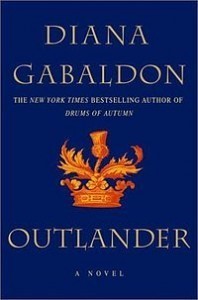
Gabaldon’s bio from the HNS website reports that she: “is the author of the award-winning, best-selling Outlander novels, described by Salon as “the smartest historical sci-fi adventure-romance story ever written by a science Ph.D. with a background in scripting ‘Scrooge McDuck comics.” Outlander began in 1991 and has continued through several more bestselling novels, with twenty million copies in print worldwide. Diana has also written a sub-series featuring Lord John Grey. Diana emcee’d the fabulous “Late Night Sex Scene Readings” at the San Diego conference in 2011, and will be reprising this scandalous event again in St. Petersburg this year.”
(I saw those Sex Scene Readings in 2011 and they were very fun!)
Without any further ado, here are Gabaldon’s fantastic, funny answers to questions created by megamind author Vanitha Sankaran, head board member of the HNS conference. Wait, no, a little more ado: I was told I could pick and choose out of the answers, but I think they’re all wonderful and thus I include them en masse.
What got you first interested in historical fiction?
I wasn’t any more interested in historical fiction than in any other kind; I just thought a historical novel might be the easiest thing for me to write for practice, since I was a research professor, and did know my way around a library. It seemed slightly easier to look things up than to make them up…and, I figured, if I turned out to have no imagination, I could steal things from the historical record.
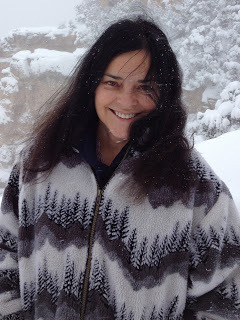
How do you find the people and topics of your books?
They just sort of show up. I think it’s probably better if I don’t try to figure out where they’re coming from.
Do you follow a specific writing and/or research process?
What, like the Palmer Method? (g) I imagine everyone’s got some routines that are specific to them, but on the whole, both writing and research are pretty organic. Personally, I do the writing and the research concurrently, because I find they feed off and reinforce each other. I have a rough sort of work schedule, but it’s flexible. I mostly write late at night, between midnight and 4 a.m.—much less intrusion and psychic noise.
For you, what is the line between fiction and fact?
Er…are you implying that there are people who don’t know the difference? (g) Fiction is stuff I make up, and facts are…you know…facts. (Though I notice with interest that one source gives two definitions of “fact”: 1. A thing that is indisputably the case.
1. 2. Information used as evidence or as part of a report or news article.
I think that’s an interesting distinction, don’t you?)
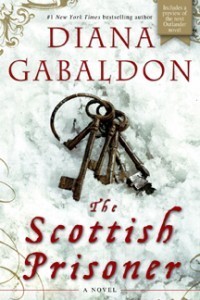
Do you have an anecdote about a reading or fan interaction you'd like to share?
Well, I have had no fewer than three young ladies come up to me at book-signings, turn around and lower their pants enough for me to see that they had “Da mi basia mille” (“Give me a thousand kisses.” It’s a quote from Catullus, used in one of my books) tattooed on their rumpuses. As my husband remarked, “It’s not everybody who can say, “Kiss my ass” in classical Latin.”
Where do you feel historical fiction is headed as a genre?
Frankly, I don’t worry about such things.
Is there an era/area that is your favorite to write about? How about to read?
The eighteenth century is one of my favorites, because it’s sufficiently near to our time that there’s a great deal of primary source material still available, and it’s reasonably accessible (in terms both of language and printing)—and at the same time, it was a huge period of intellectual, scientific and political upheaval and ferment. As for reading, I’ll read anything, as long as it’s well written.
What are your favorite reads? Favorite movies? Dominating influences?
I read so much of everything, it’s hard for any one influence to be truly dominant. Still, there are five writers whom I’d acknowledge as what you might call literary role models: Charles Dickens, Robert Louis Stevenson, John D. MacDonald, Dorothy L. Sayers, and P.G. Wodehouse.
Is there a writer, living or deceased, you would like to meet?
I do meet them, in the pages of their books. Writers really can’t hide, you know; everything they are is right there on the page.
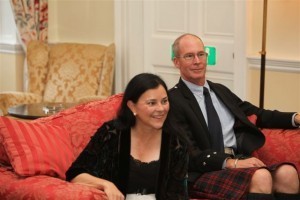
What book was the most fun for you to write?
It’s always the one I’m presently working on, because that’s the one I don’t yet know everything about. (g)
Can you tell us about your latest publication?
Well, the eighth Big OUTLANDER novel is coming right up, later this year. That’s WRITTEN IN MY OWN HEART’S BLOOD, set in 1778 (and in the 1980’s), in Colonial America (and Scotland…maybe a little bit in the Caribbean, I haven’t decided yet), and featuring All Kinds of Things, some of which are guaranteed to make the readership scream and hop up and down like peas on a hot shovel, and others that will make them melt into little puddles of goo. The most important thing is probably that THIS IS NOT THE LAST BOOK. (I’m pretty sure the ninth one is the final one.)
Do you have a most interesting question or crazy anecdote related to your writing you would like to share?
Fortunately, my books seem to attract fairly benign nuts. I think this is probably because anyone who’s truly crazy doesn’t have a long enough attention span to read one.
*
Benign nuts, indeed. I think I qualify! Thanks so much, Diana, for taking the time to share your insights into your writing and thinking process
. . . . . .
Published on May 16, 2013 23:27



